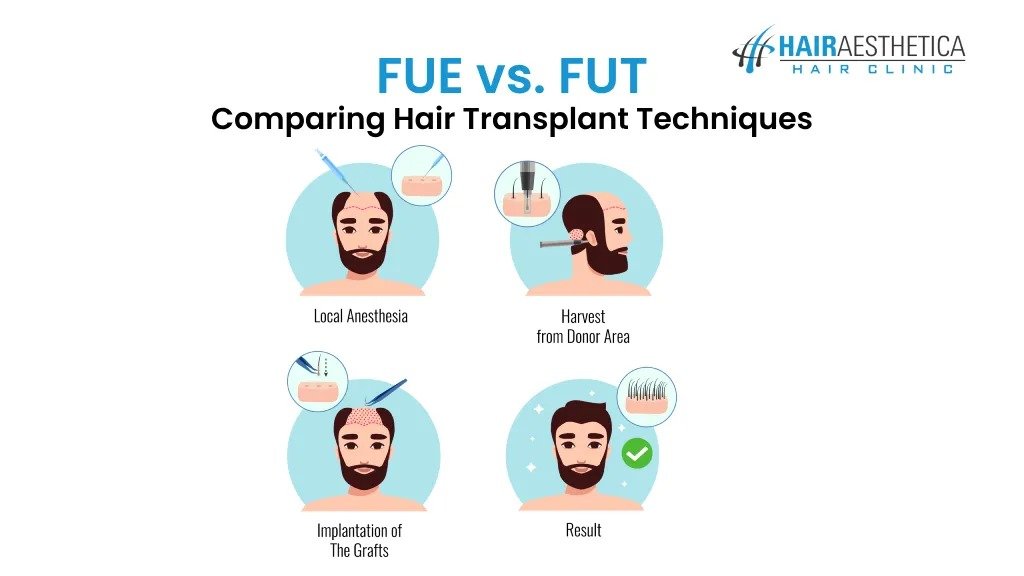
In the ever-evolving world of medical science, hair restoration has become a blessing in disguise for people suffering from receding hairline, crown baldness, or diverse hair loss issues. With the help of technologically advanced and minimally non-invasive procedures of hair restoration, it is nowadays possible to attain natural-looking results. Generally, FUE (Follicular Unit Extraction) and FUT (Follicular Unit Transplantation) are among the major Hair Transplant Techniques used by surgeons to offer tailored results. Even though the two procedures have a common vision, their mechanism differs in terms of results, recovery, and mechanism. Thus, in order to make the practical decision-making when choosing hair transplant surgery, it is essential to understand the major differences between FUE and FUT treatment.
Differences in terms of procedure
FUE
With the help of the specialized clinical tool, the individual follicular units are extracted directly from scalp in the FUE hair transplant. Due to the lesser incisions involved in this method, it proves to be the minimally invasive option for hair restoration.
FUT
A strip of skin containing hair follicles is removed from the donor area in the FUT hair transplant procedure. Generally, the back of the head qualifies as the donor area in this procedure also known as the strip method. In the next step, the follicular units are extracted from the skin for executing the hair transplant procedure.
Recovery time distinction
FUE
Since FUE is a minimally invasive hair restoration process, it involves a shorter recovery time. The lesser discomfort experienced by patients during and after the hair transplant helps them resume their daily activities within a few days.
FUT
This type of hair transplant surgery involves a longer time for recovery due to the stitches, incisions, and deeper tissue manipulation included. The patients are advised to avoid strenuous activities for a longer time to heal in a better way. Alternatively, the intensity of discomfort is higher in the case of the FUT Hair Transplant Techniques.
Scarring difference
FUE
The minor scarring in the form of a tiny dotted form remains on the scalp (donor area) of the individual after the FUE hair transplant procedure. However, these scars are not really visible even if the hair length is normal.
FUT
The linear scarring is experienced by the candidate after undergoing the FUT Hair Transplant Techniques. Since the strip of skin is removed, the scarring tends to form in that area. Nevertheless, surgeons that use best-in-class methodologies and have a rich experience in hair restoration, cover the scar through maximum hair coverage techniques. But, it should be noted that if the person has extremely short hair length, then, this linear scarring can be visible.
How to choose the best hair transplant procedure from Hair Aesthetica?
At Hair Aesthetica, we value all our candidates to help them achieve their hair restoration goals effectively and naturally. Specifically, in the case of beginners who have less or no knowledge about hair transplants, we start with a discussion of hair loss and the scope of hair restoration after the surgery. After briefing them, we determine the eligibility of candidates through clinical tests and proceed with the consultation involving the suitability of hair transplant according to the severity of hair loss. In this segment, our experienced hair specialists record the details related to hair density, hair loss patterns, and individuals’ expectations.
After these steps, the compatibility of FUE and FUT is evaluated by our highly qualified doctors. On average, we recommend the FUE procedure for people who look for short hair length after hair restoration, wherein, the scars are not visible. On the other hand, if a larger number of hair grafts is required for hair restoration, then, we recommend the FUT procedure. If you are looking for a cost-effective and well-tailored hair transplant solution, then, contact Hair Aesthetica, today, to seek consultation!

